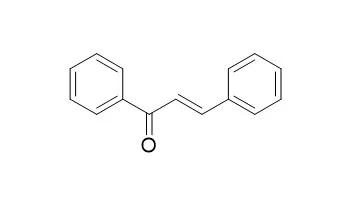| Kinase Assay: |
| Current Cancer Drug Targets, 2014, 14(2). | | Molecular Targeted Approaches to Cancer Therapy and Prevention Using Chalcones.[Reference: WebLink] | There is an emerging paradigm shift in oncology that seeks to emphasize molecularly targeted approaches for cancer prevention and therapy.
METHODS AND RESULTS:
Chalcones (1,3-Diphenyl-2-propen-1-ones), naturally-occurring compounds with widespread distribution in spices, tea, beer, fruits and vegetables, consist of open-chain flavonoids in which the two aromatic rings are joined by a three-carbon α, β-unsaturated carbonyl system. Due to their structural diversity, relative ease of chemical manipulation and reaction of α, β-unsaturated carbonyl moiety with cysteine residues in proteins, some lead chalcones from both natural products and synthesis have been identified in a variety of screening assays for modulating important pathways or molecular targets in cancers. These pathways and targets that are affected by chalcones include MDM2/p53, tubulin, proteasome, NF-kappa B, TRIAL/death receptors and mitochondria mediated apoptotic pathways, cell cycle, STAT3, AP-1, NRF2, AR, ER, PPAR-γ and β-catenin/Wnt. Compared to current cancer targeted therapeutic drugs, chalcones have the advantages of being inexpensive, easily available and less toxic; the ease of synthesis of chalcones from substituted benzaldehydes and acetophenones also makes them an attractive drug scaffold.
CONCLUSIONS:
Therefore, this review is focused on molecular targets of chalcones and their potential implications in cancer prevention and therapy. |
|






 Cell. 2018 Jan 11;172(1-2):249-261.e12. doi: 10.1016/j.cell.2017.12.019.IF=36.216(2019)
Cell. 2018 Jan 11;172(1-2):249-261.e12. doi: 10.1016/j.cell.2017.12.019.IF=36.216(2019) Cell Metab. 2020 Mar 3;31(3):534-548.e5. doi: 10.1016/j.cmet.2020.01.002.IF=22.415(2019)
Cell Metab. 2020 Mar 3;31(3):534-548.e5. doi: 10.1016/j.cmet.2020.01.002.IF=22.415(2019) Mol Cell. 2017 Nov 16;68(4):673-685.e6. doi: 10.1016/j.molcel.2017.10.022.IF=14.548(2019)
Mol Cell. 2017 Nov 16;68(4):673-685.e6. doi: 10.1016/j.molcel.2017.10.022.IF=14.548(2019)